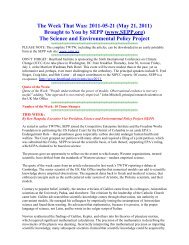Nature, Not Human Activity, Rules the Climate - Science ...
Nature, Not Human Activity, Rules the Climate - Science ...
Nature, Not Human Activity, Rules the Climate - Science ...
Create successful ePaper yourself
Turn your PDF publications into a flip-book with our unique Google optimized e-Paper software.
verification of <strong>the</strong> IPCC’s analysis of land surfacetemperatures.Objections to <strong>the</strong> surface data are too numerousto elaborate here in detail [see Lo, Yang, Pielke2007; McKitrick and Michaels 2004, 2007]. Theyhave been vigorously criticized for failing tosufficiently control for urban heat-island effects –<strong>the</strong> fact that asphalt, buildings, air conditioningunits, and o<strong>the</strong>r parts of urban life cause warming ofurban areas that has nothing to do with greenhousegases. One study of temperature stations inCalifornia found no warming in rural counties, aslight warming in suburban counties, and rapidwarming in urban counties (Figure 11). [Goodridge1996]Ano<strong>the</strong>r criticism of <strong>the</strong> temperature record ispoor geographic distribution and sampling. Thenumber of stations has varied greatly over time andhas decreased markedly from <strong>the</strong> 1970s, especiallyin Siberia, affecting <strong>the</strong> homogeneity of <strong>the</strong> dataset(Figure 12). Ideally, <strong>the</strong> models require at least onemeasuring point for each 5 degrees of latitude andlongitude – 2,592 grid boxes in all. With <strong>the</strong> declinein stations, <strong>the</strong> number of grid boxes covered alsodeclined – from 1,200 to 600, a decline in coveragefrom 46 percent to 23 percent. Fur<strong>the</strong>r, <strong>the</strong> coveredgrid boxes tend to be in <strong>the</strong> more populated areas.Figure 12: The number of (a) global wea<strong>the</strong>r stations and (b)grid boxes [Peterson and Vose 1997]. The top curve (solid)shows stations providing ‘mean values’; <strong>the</strong> dashed curveshows stations supplying ‘max-min’ values. The rise and fall ofcovered grid boxes (of 5º x 5º) supplying ‘mean values’ (solid)and ‘max-min’ values (dashed). Coverage is seen to be ra<strong>the</strong>rpoor since <strong>the</strong> possible number of global grid boxes is 2,592.Figure 11: A demonstration of <strong>the</strong> ‘urban heat island’ effect:Observed (surface) temperature trends from California wea<strong>the</strong>rstations are shown to depend on population density: (A)Counties with more than 1 million people, (B) 100k to 1 million,(C) less than 100k people, respectively [Goodridge 1996]. Butnote that all three [High, Medium, and Low density] show atemperature rise up to 1940, followed by a pronounced cooling.An error in <strong>the</strong> analysis of <strong>the</strong> NASA-GISSsurface data for <strong>the</strong> U.S. was discovered recently byStephen McIntyre [2007]. As a result, <strong>the</strong> year 1934has emerged as <strong>the</strong> warmest of <strong>the</strong> twentieth centuryfor <strong>the</strong> U.S., and <strong>the</strong> 1930s as <strong>the</strong> warmest decade.Data on sea-surface temperatures (SST) haveincreasingly been obtained from buoys and satellitesra<strong>the</strong>r than ships – raising a different set ofproblems stemming from inhomogeneous datasources. Balloon data can overcome some of <strong>the</strong>seproblems, but only satellites provide true globalcoverage and a homogeneous dataset for <strong>the</strong> Earth’satmosphere.Finally, <strong>the</strong>re is a general question of how todefine a trend in view of its dependence on <strong>the</strong>choice of an appropriate time interval. This problemis made more difficult by <strong>the</strong> occurrence of frequent9





